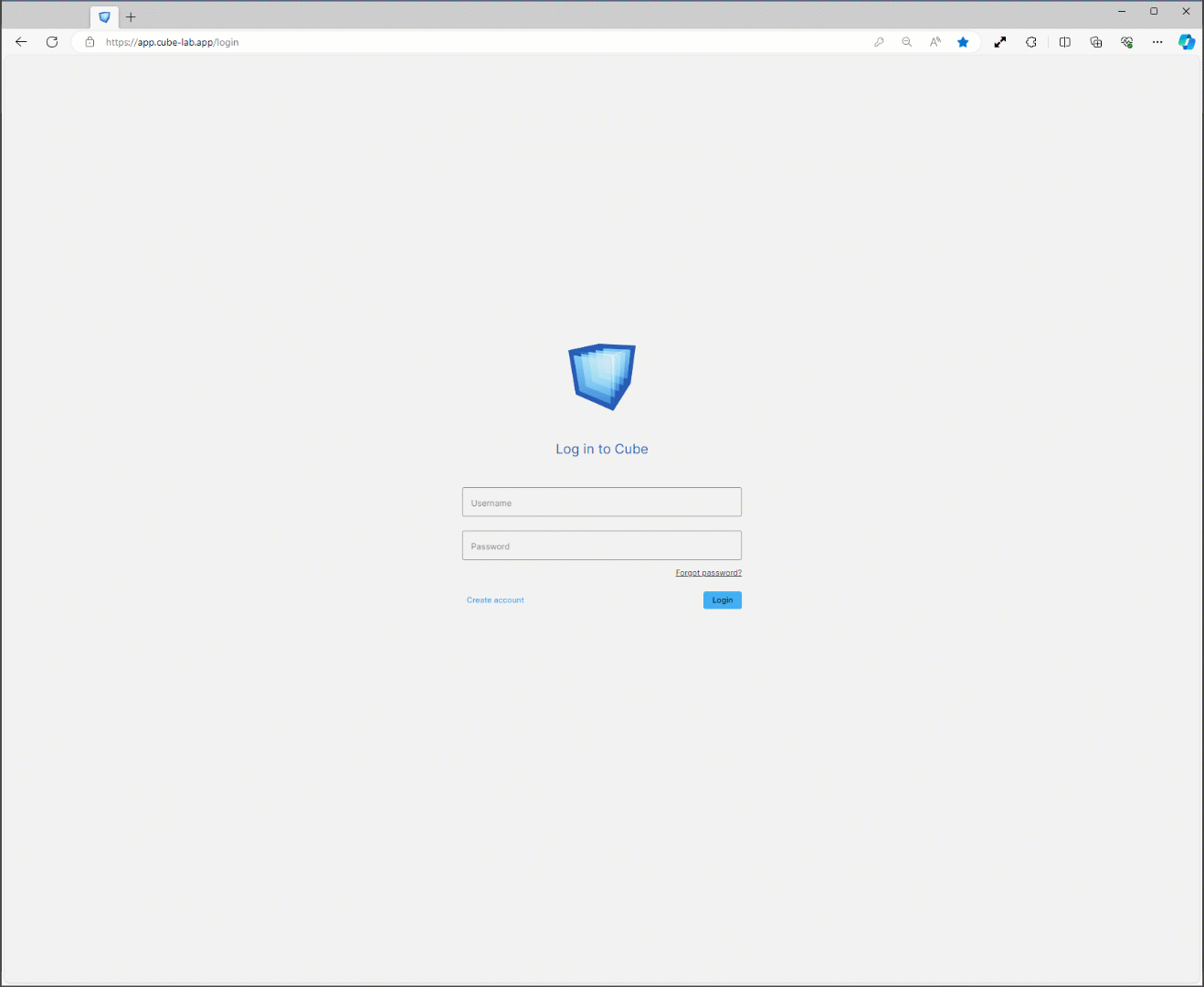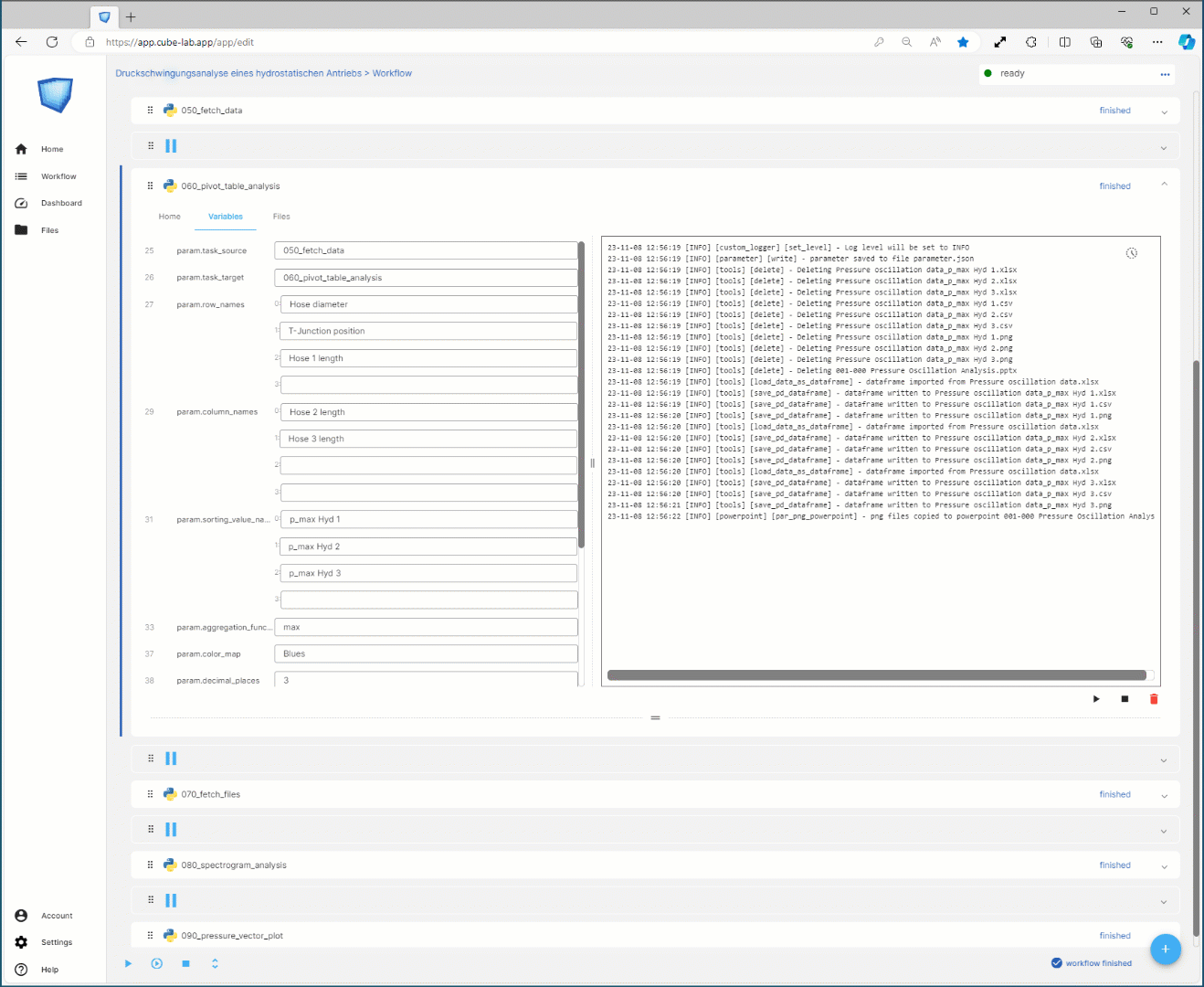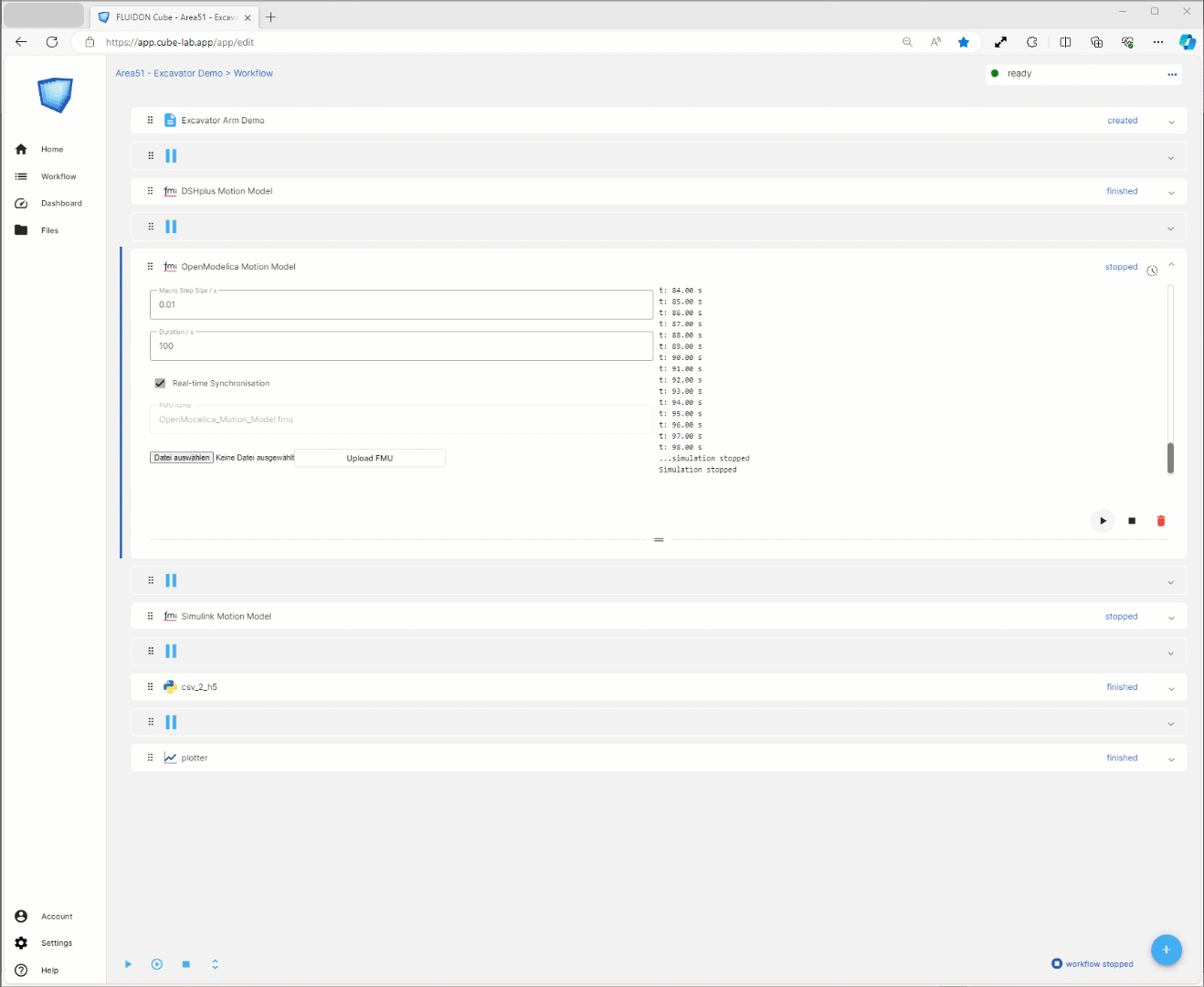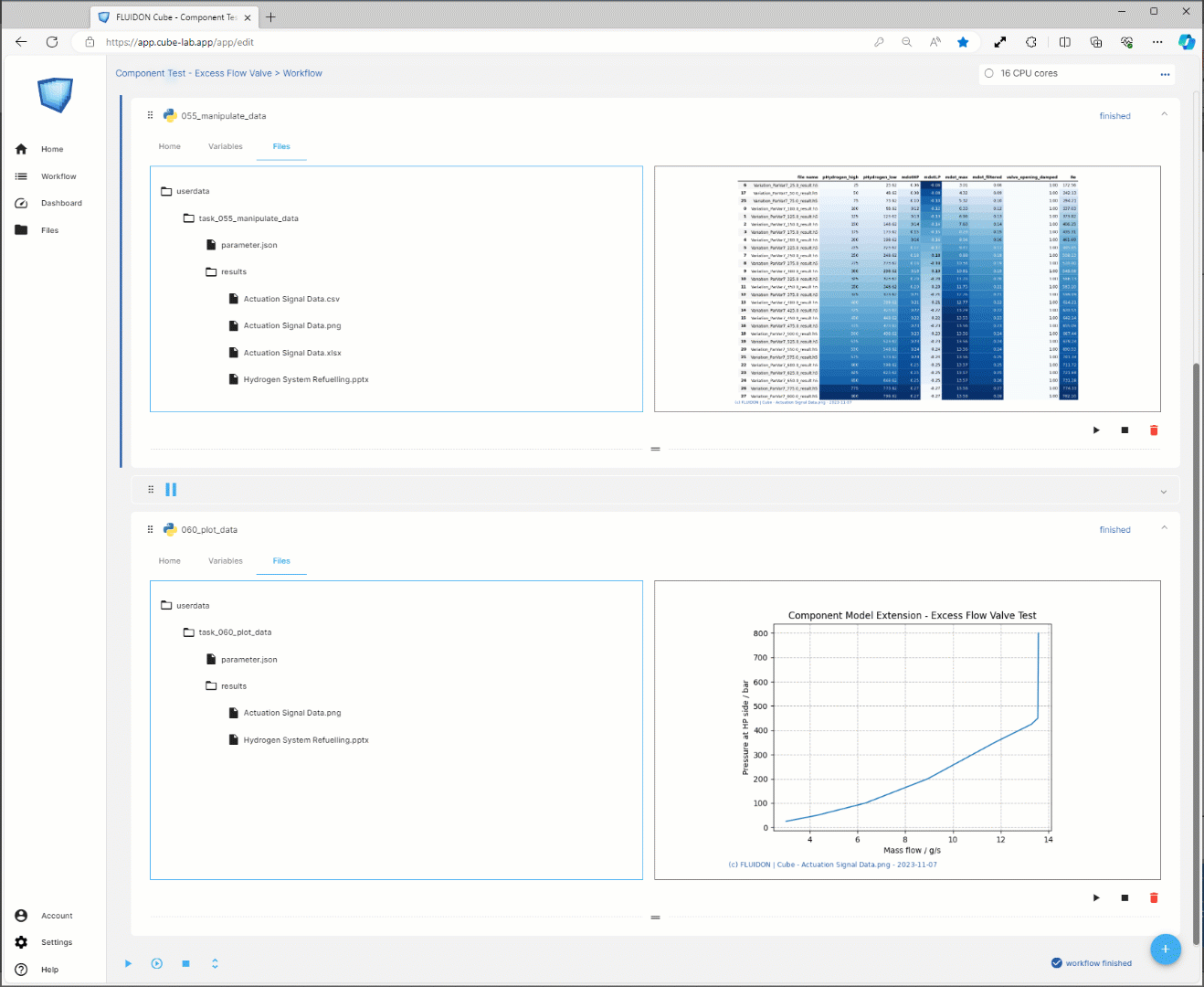Customized Cube Workflows
FLUIDON supports you in designing customised Fluidon Cube workflows. Our experts develop customised workflows that are precisely tailored to your requirements. Among other things, we offer workflows for simulative function validation as well as workflows for automated analysis of measurement data.
Our comprehensive services at a glance:
- Methodological consulting: We support you in the conceptual design of your measurement data or simulation model evaluation.
- Data integration: We create import modules for you to integrate data from different sources and/or with different formats, structures and standards into the Cube Workflow.
- Customized evaluation functions: Our experts develop evaluation functions that exactly meet your requirements.
- Customized parameter input: We integrate user-defined parameter input, e.g. via individually configurable Excel sheets.
- Seamless workflow: Our team designs the workflow for you - including automatic reporting.
- SaaS deployment: Benefit from our flexible SaaS application with on-demand Fluidon Cube rental model for cube workflows.
Streamline your development processes and increase the efficiency of your system development with our customized solutions. Our experts are here to help you make your projects more effective and achieve your goals faster. Contact us today to learn more about the capabilities of Fluidon Cube Workflows.
How does FLUIDON specifically support you in creating a Cube workflow?
Workflow creation
- Creating a simulation model or setting up a test bench is not done without reason. Every simulation and every test serves to answer specific questions, whereby in both cases a data file is generated at first.
- Working with these data files is often characterised by recurring work steps (tasks), some of which can be automated. Each task is independent, but interacts with other tasks. By linking many individual tasks in a meaningful way, complex workflows can be created that relieve developers of repetitive work steps.
- However, designing and creating the workflow is no trivial task. It requires the integration of data from different sources and their conversion into a standardised format that is understood by all tasks in the workflow. The actual analysis task must be divided into meaningful work steps, the so-called tasks, and their interfaces must be designed. Attention must be paid to the reusability of the tasks in order to create a modular system of tasks that enables the flexible creation of workflows for new tasks.
- FLUIDON consistently relies on the modular task approach when realising its own engineering projects. Many of the resulting tasks are also available to Cube users as documented high-level functions and can be used in their own workflows.
- FLUIDON is also happy to create your workflow as part of an engineering project. Here you benefit from our expertise with the task modules already available and missing tasks can be created quickly for your application. This means you receive your workflow faster and can start using it promptly.
- We will be happy to advise you on the design of your workflow.
Do not hesitate to contact us!
Tabular data processing
- FLUIDON uses Pandas for processing spreadsheet data. Pandas is a Python library for processing, analysing and displaying data. With the DataFrame, Pandas has a data structure that enables large amounts of data to be handled quickly and efficiently.
- Data from various sources such as CSV files, Excel tables or database queries can be loaded into a Pandas DataFrame. The DataFrame also offers a variety of functions and methods for data manipulation, analysis and visualisation.
- Cube has a number of high-level functions prepared by FLUIDON for direct interaction with the DataFrame without the user having to work with the complex details of the Pandas library. This allows the user to easily perform advanced data manipulations that are intuitively parameterised via the Cube interface.
- By default, a DataFrame is output in the form of a Microsoft Excel workbook. However, Cube also offers the option of formatting a Pandas DataFrame and exporting it as a visually appealing PNG graphic. This graphic can be automatically inserted into a PowerPoint file by the Cube workflow.
- As part of FLUIDON Engineering projects, we are continuously expanding the number of prepared high-level functions. If you cannot find the function you need to set up your workflow in the Cube Help, please do not hesitate to contact us.
- Of course, you also have the option of designing your own Pandas DataFrame analysis in the Python editing field of the cube workflow. The existing high-level functions for loading and saving the DataFrame relieve you of the tedious file handling.
Simulation & 3D animation
- Cube can import Linux 64-bit FMUs (Functional Mockup Units) that comply with the FMI standard 2.0 Co-Simulation Stand-Alone. It is also possible for the simulation model on which the FMU is based to integrate FMUs itself (composite model).
- Signals that are modelled as outputs within the FMU are saved in a results file and can therefore be further processed in a cube analysis workflow.
- Currently (12/2023) FMUs of the following programs have been successfully tested:
- DSHplus
- OpenModelica
- Mathlab/Simulink
- Hopsan
- Altait TwinActivate
- Cube has a visualisation module based on the Unity engine, an extremely popular and powerful development environment for creating 2D and 3D games, simulations, virtual reality (VR) applications, augmented reality (AR) applications and other interactive content.
- The results of the FMU simulation can be used to control the animation of a structure in the visualisation. The user only has to ensure that the names of the signal outputs of the FMU match the names of the signal inputs of the visualisation. The Cube Databackbone then automatically links the output variables of the FMU simulation with the inputs of the animated structure in the visualisation module.
- If you are interested in a customised visualisation for your application, we will be happy to assist you. As part of our services, we can either create the visualisation based on your existing CAD data or redesign it entirely according to your individual ideas - whether in 2D or 3D. Get in touch with us!
Customised result graphics
- Experts in data analysis with Python are aware that the possibilities for data visualisation are almost limitless. However, this is precisely why selecting the optimal visualisation method for your own application requires a certain amount of experience.
- The subsequent realisation of your own visualisation project is no less demanding. To ensure that the graphic not only shows the result of a simulation or measurement, but also presents it in an aesthetically pleasing way, this requires the fine-tuning of numerous layout parameters.
- Many of the result visualisations that we at FLUIDON have created specifically for our workflows are also available to Cube users as ready-to-use high-level functions. They can easily integrate these functions into their own Cube workflows. The functions only require the configuration parameters described in the Cube help. Numerous workflow templates are available in the demo projects of your Cube account, which you can use as a reference.
-
If you cannot find the function you need to display your results in the Cube Help, please do not hesitate to contact us. This is where you can make use of the services offered by FLUIDON. Thanks to our daily work on cube workflows, we have extensive expertise in the graphical visualisation of data with Python. Whether it's a simple line diagram, the representation of a data matrix as a contour plot or heat map, or a complex 3D representation. Contact us and we will be happy to create a visualisation of the results that is optimally tailored to your application.
Customised extensions
- The functions of a task are defined by Python scripts. When creating these scripts, the user can access a comprehensive collection of high-level functions that are documented in the Cube help. If the function you require is not listed here, please do not hesitate to contact us.
- The user has the option of entering Python scripts directly in the editor or copying them via the clipboard. The copy-paste function even allows source code parts to be copied directly from AIs such as ChatGPT, which (if used correctly!) can make it easier and faster to create your own Python scripts.
- If the user already has an extensive collection of their own Python scripts that they would like to use in their Cube workflow, this is no problem. Similar to the management of Python libraries in the "site-packages" folder, user-specific scripts can be "installed" in a subfolder of the workflow. These scripts are only available in the respective workflow, which means that your own expertise remains protected.
- We would be happy to support you in integrating your Python scripts into your Cube workflow. Get in touch with us!





